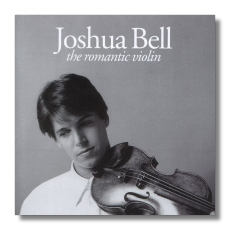
The Internet's Premier Classical Music Source
Related Links
- Latest Reviews
- More Reviews
-
By Composer
-
Collections
DVD & Blu-ray
Books
Concert Reviews
Articles/Interviews
Software
Audio
Search Amazon
Recommended Links
Site News
 CD Review
CD Review
Joshua Bell

The Romantic Violin
- Johannes Brahms:
- Hungarian Dance #1 (arr. Joachim) 1
- Concerto for Violin in D Major, Op. 77 (Adagio) 2
- Max Bruch: Concerto for Violin #1 in G minor, Op. 26 (Adagio) 3
- Niccolò Paganini: Cantabile 1
- Samuel Barber: Concerto for Violin Op. 14 (Andante) 4
- Fritz Kreisler: 5
- Schön Rosmarin
- Tambourin Chinois, Op. 3
- Liebesfreud
- Liebesleid
- Cesar Auguste Franck: Sonata for Violin in A Major (Allegretto ben moderato) 6
- Henryk Wieniawski: Concerto for Violin #2 in D minor, Op. 22 (Romance) 2
- Piotr Ilyitch Tchaikovsky: Concerto for Violin in D Major, Op. 35 (Canzonetta) 2
- Jules Emile Massenet: Méditation (Thaïs) 7
- Édouard Lalo: Symphonie espagñole (Rondo) 8
Joshua Bell, violin
1 Samuel Sanders, piano
5 Paul Coker, piano
6 Jean-Yves Thibaudet, piano
2 Cleveland Orchestra/Christoph von Dohnányi
3 Academy of St. Martin-in-the-Fields/Neville Marriner
4 Baltimore Symphony Orchestra/David Zinman
7 Royal Philharmonic Orchestra/Andrew Litton
8 Montréal Symphony Orchestra/Charles Dutoit
Decca 475617-5 DDD 80:09
As the name suggests, this is a smoochy violin CD, not one that is focused on jaw-dropping feats of agility – in other words, it is romantic, not Romantic. (The bulk of the music comes from the Romantic era, however.) It appears that Decca got the idea for this compilation from Romance of the Violin, a best-selling CD that Bell recorded for Sony Classical in 2003. That CD consisted entirely of arrangements for violin and orchestra; this one sticks, for the most part, to "real" violin music. (The exception is Brahms' Hungarian Dance #1.) The Sony CD was, frankly, soupy. The present one is sweet, but not overly so.
Bell recorded this material between 1986 and 1996. He went a long way during that decade. Early on, Decca capitalized on his Midwestern good looks, no doubt trying to make classical music attractive for the girls (well, maybe some guys too!) who read Tiger Beat in Borders Books. Fortunately, Bell's musicianship survived this kind of treatment, and now he's appreciated for the correct characteristics: strong and lyrical violin playing. (That's hasn't kept Decca from placing photographs of the younger Bell all over the CD booklet.) I will say that he is a more exciting violinist live, however.
The repertoire is divided between concertos (slow movements only, except for the finale of Lalo's Symphonie espagñole) and more active pieces for violin and piano. The concertos are those by Bruch (#1), Barber, Brahms, Wieniawski (#2 ), and Tchaikovsky. The last ends without a full stop, a fact that Decca sloppily ignores by simply cutting away before the start of the finale. The Barber is treasurable, though, and I very much enjoyed the selection of four works by Fritz Kreisler: Schön' Rosmarin, Tambourin chinois, Liebesfreud, and Liebeslied. (Paul Coker is the pianist in these.)
This collection offers nothing new for Bell's many fans. It doesn't really seem to have been put together with the serious classical collector in mind, but it is an enjoyable late-night indulgence for the "chill" crowd. In spite of the varying venues and dates, the engineering is consistently good. Stephen Johnson's booklet notes are superficial – predictable, for a project such as this one.
Copyright © 2004, Raymond Tuttle



















